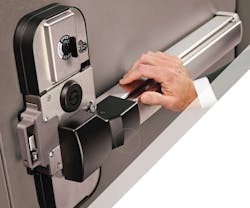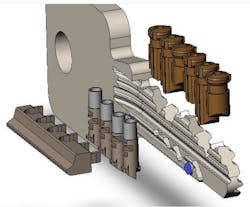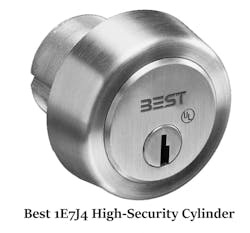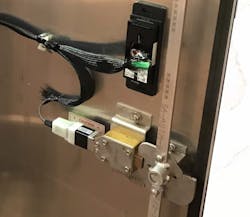The world is full of clever felons who will figure out how to penetrate, bypass or overwhelm the most creative lock solution. That’s why high security always requires multiple layers to deter, detect, delay and defend against felonious attacks.
External threats come from brute-force attacks or sophisticated manipulation or bypass efforts. However, the most frequent threat actually is internal, from lost, stolen, copied, loaned or unreturned keys. Your role is to provide professional advice on the door, frame, hinges, closer, lock and internal key-control processes.
Four things you must find out prior to making any recommendations:
- What assets must be protected?
- What are the possible threats?
- What alarms, video, guard tours and other security layers will be present?
- What regulations govern the customer’s site, business or application?
Recent innovations have provided us with improved high-security options. This article will explore how, what’s available, where they might be applicable and what you should know about high security before recommending solutions.
Deter, Delay, Defend
High-security locks can protect against external threats from brute-force attacks and surreptitious entry attempts, but you should consider the entire opening, and think in terms of layers.
Visible delaying features, such as the Frontline Defense astragal and wrench-proof cylinder collars, suggest that this might not be the door to attack. Heavy-duty components, such as armored face plates, robust deadbolts, reinforced cylinder set screws and hinge pins add layers that slow an attacker. Extreme service locks, such as the Securitech Auto-Bolt MAX, stop even the most determined assaults.
Meanwhile, defeat-resistant keying can make manipulation difficult and time-consuming. Patented keying and good internal key control protect against unaccounted-for keys.
Adding electronic accountability can enhance the level of security dramatically while reducing the issue of key duplication. Alarm contacts and surveillance add important layers as well.
Your role is not to “sell” the customer but to review the threats and recommend practical and cost-effective solutions depending on a number of conditions.
High-Security Standards
Padlocks are rated grades 1-6 in ASTM F883. The Central European Standard (CEN) has somewhat similar ratings. Grade 4 is considered to be high security for a padlock; grade 5 is extra high; and grade 6 is considered to be maximum security.
Wind, tornado and hurricane building codes have become relevant in coastal states and Tornado Alley, and that has forced the use of products that might be considered to be high security in those areas. Standards and products are covered under FEMA 320 and 361, ASTM E330 and the Florida Building Code. Corbin Russwin, SARGENT, Schlage and Securitech offer multipoint locks that meet various wind-standard levels.
On the Menu
High-security locks generally provide upgraded levels of pick, bump and tamper resistance to start. Cylinders will have substantial wrench, hammer and drill protection. Extreme levels of pick and tamper resistance also might be worthwhile where sophisticated attacks might go unobserved, such as at remote utility sites.
Major domestic manufacturers, such as BEST, Corbin Russwin, SARGENT and Schlage, generally offer pick- and tamper-resistant cylinders or cores. ABUS, ASSA, Kaba, Mul-T-Lock and other offshore companies have various high-security cylinder offerings, as well. Canada’s easily pinned CX5 sidebar cylinders are available in large-format and small-format interchangeable core (SFIC) versions.
The BEST UL 437 listed 1E7J4 cylinder is an example of how an SFIC can be secured. The hardened stainless steel ring, face plate and free spinning keyway face guard prevent wrench, drill and puller attacks. The face guard also adds considerable delay to pick, tamper and bump efforts. The internal SFIC has double steel locking lugs, plus an additional internal set screw, which effectively prevents puller attacks. Patented keyways and spool pins are available.
Grade 1 auxiliary deadbolts generally resist saw and hammer attacks. Reinforced strikes are certainly critical to the integrity of any high-security opening. Mortise locks that attain BHMA Grade 1 ratings generally have reinforced deadbolt components, armored faceplates and anti-tamper screws available.
Securitech lock assemblies provide robust multipoint devices. A face-mounted trigger allows automatic deadbolt engagement of up to three bolts for the Auto-Bolt MAX versions.
Electronics add important additional layers of security. Mortise locks generally have contacts for door position, latch and deadbolt engagement available for hard-wired and Wi-Fi applications. Mobile credential readers are becoming standard fare and soon will be available for battery-operated locks as well. Meanwhile, electronic key systems made by CyberLock as well as Medeco provide an audit trail while keeping locking devices physically secure.
Market Opportunities
The following are logical applications for high-security products:
IT departments everywhere require higher levels of security. Even small businesses have to secure their file servers. Unfortunately, we’ve seen electronic readers installed on openings that are compromised easily. The entire opening matters.
Medical facilities, naturally, are a huge potential market as the wave of mobile credentials brings low-cost accountability to cabinets and drawers, as well as medical record producing, transmission and storage areas. Mobile credentialed locks soon will replace many thousands of mechanical cabinet and drawer locks in this market.
The manufacture, transport, storage and distribution of pharmaceuticals and drugs are coming under much closer scrutiny. Manufacturing in North America and other well-regulated counties is driven by “best practices.” This means clean materials, clean manufacturing, a secure processing environment — and strict accountability. High-security locks are desirable in many of these locations.
Sargent and Greenleaf has developed a series of specialized high-security locks for Department of Defense applications. The 951 padlock targets applications governed by MIL-DTL-43607J for perimeter security. The S&G 2890C exit device was developed specially to provide life safety that meets Mil-Specs for Secure Compartmented Information Facilities (SCIF) applications.
Industrial and manufacturing facilities often require secure tool cribs and test equipment storage. Valuable, sterile or dangerous materials, utility rooms and electrical vaults might warrant higher levels of security. High-value finished goods and proprietary processes or formulas often require higher security.
Critical infrastructure is a huge category where the federal government now exercises oversight. Sixteen sectors include communications, energy, food, transportation and water. Most of these have some high-security lock applications.
For example, cities actively secure traffic-control boxes at intersections. The HES 630 lock and Medeco’s XT traffic cabinet lock provide remote electronic security for the many thousands of these critical traffic controls.
Most electrical power, water and wastewater utilities are classified as critical infrastructure, and these sites often are remote and unmanned. Remote critical infrastructure sites require robust, high-security locks. Most of these utilities have internal lockshops that deal with routine high-security applications, but smaller utilities might use independent shops, and larger shops might engage outside help from time to time.
Schools have become a prime market. Although many schools upgraded to quick internal locking options, recent reports indicate that at least 25% of North American schools haven’t upgraded. Patented keying or high levels of tamper resistance haven’t been an issue for classroom protection. All domestic lock manufacturers now offer quick lock-down options. The Securitech Safebolt provides a solid code-compliant add-on classroom deadbolt. Other areas in a school might require higher levels of security.
Deter, detect, delay and defend. Ask questions that allow the customer to discover what must be protected and what practical threats they face. Only then can you make recommendations. And don’t forget: The entire opening matters.
Cameron Sharpe, CPP, worked 30 years in the commercial lock and PACS industry. [email protected]








